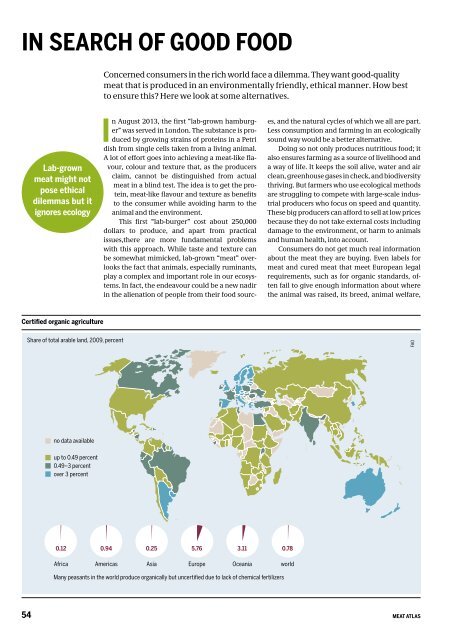IN SEARCH OF GOOD FOODConcerned consumers in the rich world face a dilemma. They want good-qualitymeat that is produced in an environmentally friendly, ethical manner. How bestto ensure this? Here we look at some alternatives.Lab-grownmeat might notpose ethicaldilemmas but itignores ecologyIn August 2013, the first “lab-grown hamburger”was served in London. The substance is producedby growing strains of proteins in a Petridish from single cells taken from a living animal.A lot of effort goes into achieving a meat-like flavour,colour and texture that, as the producersclaim, cannot be distinguished from actualmeat in a blind test. The idea is to get the protein,meat-like flavour and texture as benefitsto the consumer while avoiding harm to theanimal and the environment.This first “lab-burger” cost about 250,000dollars to produce, and apart from practicalissues,there are more fundamental problemswith this approach. While taste and texture canbe somewhat mimicked, lab-grown “meat” overlooksthe fact that animals, especially ruminants,play a complex and important role in our ecosystems.In fact, the endeavour could be a new nadirin the alienation of people from their food sources,and the natural cycles of which we all are part.Less consumption and farming in an ecologicallysound way would be a better alternative.Doing so not only produces nutritious food; italso ensures farming as a source of livelihood anda way of life. It keeps the soil alive, water and airclean, greenhouse gases in check, and biodiversitythriving. But farmers who use ecological methodsare struggling to compete with large-scale industrialproducers who focus on speed and quantity.These big producers can afford to sell at low pricesbecause they do not take external costs includingdamage to the environment, or harm to animalsand human health, into account.Consumers do not get much real informationabout the meat they are buying. Even labels formeat and cured meat that meet European legalrequirements, such as for organic standards, oftenfail to give enough information about wherethe animal was raised, its breed, animal welfare,Certified organic agricultureShare of total arable land, 2009, percentFAOno data availableup to 0.49 percent0.49–3 percentover 3 percent0.12 0.94 0.255.76 3.11 0.78Africa Americas Asia Europe Oceania worldMany peasants in the world produce organically but uncertified due to lack of chemical fertilizers54MEAT ATLAS
attitudes towards meat in a wealthy societyGerman consumers’ attitudes to individual and ethical issues of meat consumption, sample, 2011percentage of respondentslow meat consumer average meat consumer heavy meat consumerKAYSER ET AL.percentage of meat in the total diet7.12 19.00 38.31general preference for meattrust in the agri-food sectorenvironmental awarenesshealth awarenessfigure awarenesseating of animalsanimal welfare awarenessstrong positive+16 to +58 index pointsmoderate negative-2 to -15 index pointsstrong negative-16 to -40 index points990 respondents, of whom 34 (3 percent) were excluded as vegetariansslaughtering and processing methods, or adviceon how to store and use the meat. Labels withfull information can restore competitive value toa product because they differentiate it from themass of goods that fail to provide relevant informationabout fundamental questions.The term “co-producer” was coined a few yearsago to highlight the power of the consumer to gobeyond a passive role, and become an influentialand active player in the production process. A coproduceris a conscious stakeholder in the foodsystem who makes conscious choices by knowingwho produces food and how.A model called “community-supported agriculture”has started to put this into practice. Thisis a mechanism that secures livelihoods for farmers,thereby supporting responsible productionpractices such as extensive, pasture-based animalhusbandry. In community-supported agriculture,a group of people guarantees the purchase of allseasonally available produce from the farmer, i.e.vegetables, meat, dairy products, honey, etc. Theyalso share the risk of dealing with natural processes.They pay in advance, thus helping to financethe production costs along the way. This arrangementis used in various countries. In German it iscalled Solidarische Landwirtschaft, in French, Associationpour le maintien d’une agriculture paysanne, and in Italian, Gruppo di acquisto solidale.This results in a win–win situation for everyoneinvolved, the customers (or members of thescheme), the farmers and their businesses, theregional economy, the animals and the environment.The customers get good, fresh produce.They know where it comes from and how it wasproduced; they learn about the food they eat, andthey expand their social networks. The farmers getfinancial and hands-on support, as well as a senseMEaT aTlaSof who they are working for. The farming businessis shielded from market fluctuations and the exploitationof human, animal or environmental resources.Appropriate practices conserve water,air and the soil.A change in food systems is unavoidable.But corporations are not the only ones that canset the rules for the food market. More information,communication and collaboration betweenproducers and consumers as “co-producers”,and greater knowledge about our roles in theglobal ecosystem can achieve real change.Customer’s alternatives: community supported agriculture (CSa)Number of US farms with growers and consumerssharing risks and benefits, estimates6,000–6,5003,600Consumersneed informationto have a say inhow their food isproduced1,00060220132009200019901986MCFADDEN55


